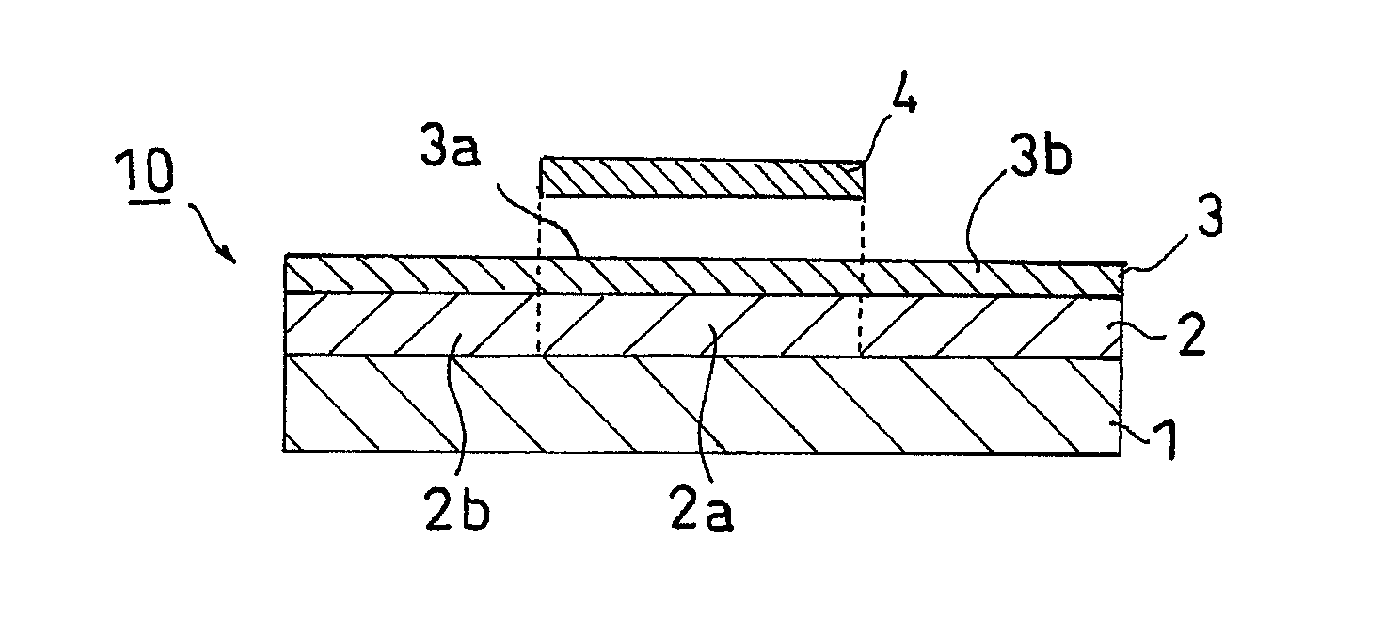Dicing die-bonding film
a die-bonding film and die-bonding technology, applied in the direction of film/foil adhesives, synthetic resin layered products, transportation and packaging, etc., can solve the problems of long time, special equipment, and difficulty in uniform adhesive layer, and achieve the effect of further improving the pick-up property
- Summary
- Abstract
- Description
- Claims
- Application Information
AI Technical Summary
Benefits of technology
Problems solved by technology
Method used
Image
Examples
example 1
Manufacture of Dicing Film
[0094]An acryl polymer A was obtained by charging 86.4 parts of 2-ethylhexylacrylate (hereinbelow, refers to as “2EHA”), 13.6 parts of 2-hydroxyethylacrylate (hereinbelow, referred to as “HEA”), 0.2 parts of benzoylperoxide, and parts of toluene into a reactor equipped with a condenser, a nitrogen introducing pipe, a thermometer, and a stirring apparatus, and performing a polymerization process at 61° C. for 6 hours in a nitrogen flow. The HEA was 20 mol %.
[0095]An acryl polymer A was obtained by adding 14.6 parts of 2-methacryloyloxyethylisocyanate (hereinbelow, referred to as “MOI”) (80 mol % to HEA) to the acryl polymer A and performing an addition reaction process at 50° C. for 48 hours in an air flow.
[0096]Next, a pressure-sensitive adhesive solution was manufactured by adding 8 parts of a polyisocyanate compound (trade name: COLONATE L, manufactured by Nippon Polyurethane Industry Co., Ltd.) and 5 parts of a photopolymerization initiator (trade name: ...
examples 2 to 9
[0101]A dicing die-bonding film was manufactured in each of examples 2 to 9 in the same manner as in the example 1 except that the composition and the content were changed to the values shown in Table 1 below.
TABLE 1Hydroxylgroup-containingIsocyanateCrosslinkingmonomercompoundagentPhotopolymerization2EHAHEA4HBAMOIAOIC / LC2030initiatorExample 186.413.6—14.6—8—5(20)(80)Example 293.5 6.6— 7.9—8—5(10)(90)Example 378.721.3—22.7—8—5(30)(80)Example 486.413.6—12.3—8—5(20)(70)Example 584—1614.2—8—5(20)(80)Example 686.413.6—13.48—5(20)(80)Example 786.413.614.6—4—5(20)(80)Example 886.413.614.6—16—5(20)(80)Example 986.413.614.6——85(20)(80)The numerical value in parentheses represents “mol”, while the numerical value in parentheses in MOI and AOI represents “molar ratio” to HEA or 4HBA.
[0102]The meanings of abbreviations described in Table 1 and Table 2 mentioned hereinafter are as follows.[0103]2EHA: 2-ethylhexyl acrylate[0104]HEA: 2-hydroxyethyl acrylate[0105]4HBA: 4-hydroxybutyl acrylate[0106]...
PUM
| Property | Measurement | Unit |
|---|---|---|
| Percent by mass | aaaaa | aaaaa |
| Percent by mass | aaaaa | aaaaa |
| Percent by mass | aaaaa | aaaaa |
Abstract
Description
Claims
Application Information
 Login to View More
Login to View More - R&D
- Intellectual Property
- Life Sciences
- Materials
- Tech Scout
- Unparalleled Data Quality
- Higher Quality Content
- 60% Fewer Hallucinations
Browse by: Latest US Patents, China's latest patents, Technical Efficacy Thesaurus, Application Domain, Technology Topic, Popular Technical Reports.
© 2025 PatSnap. All rights reserved.Legal|Privacy policy|Modern Slavery Act Transparency Statement|Sitemap|About US| Contact US: help@patsnap.com



